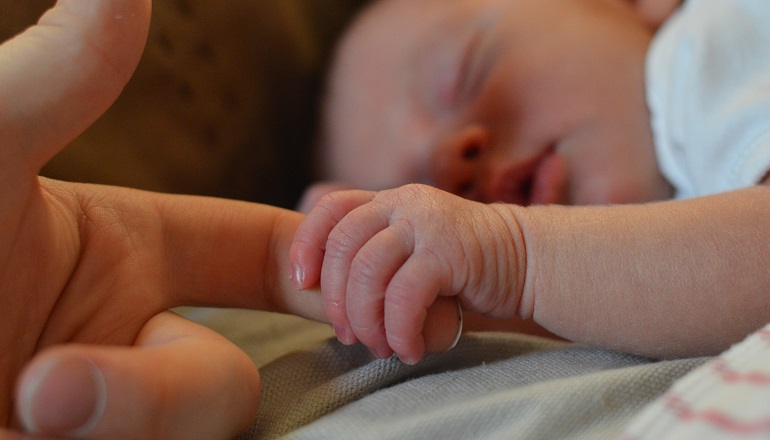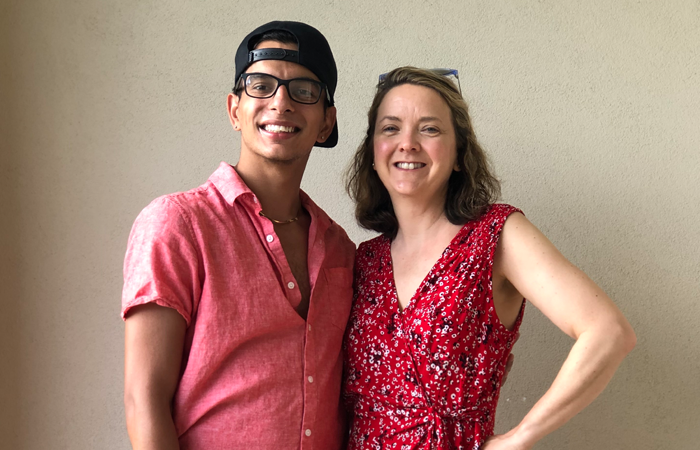We were very worried about attachment before we adopted our son Giovanni. When we first started the adoption process, we just assumed our child would attach to us. Then we took a required course, and our instructor continually stressed the importance of attachment. When we finally met our 4-day-old son, we immediately put into practice the things we had learned, such as having him sleep in our bed, so he would get used to our scents. We would hold him either on our bare chests or in our bare arms. Our doctor informed us that this was essential to bonding, and to his receiving our antibodies.
Our son is now 2 years old and thoroughly attached, and all my worries during the first year about attachment have disappeared. —The Cristini family, California
I had always assumed that I would be placed with a little girl. When I got a call saying that there was a baby available, the due date was days away, and it was a boy, I was worried. I am an only child, and I would be a single mom. How would I bond? Could I be a 'boy' mom? On the plane to Hawaii, I was happy, but anxious. When we left the hospital, we were alone in a hotel room for about 10 days, and it was there we really bonded. I gave him lots of kisses when bathing, feeding, and cuddling him. I talked to him constantly, narrating what was happening. I read to him. I told him I loved him about one hundred times a day. Two years later, he loves to hug and give kisses! —Sharon, Pennsylvania
[Instant eBook: Adopting a Newborn in the U.S.]
While my husband and I were making a plan to adopt internationally, the local agency doing our home study told us there was a birth mother on our island that wanted to make an adoption plan. We had originally shied away from domestic adoption, mostly due to our ignorance about it. But we felt compelled to follow this. They had called us on Tuesday, Caleb's birth mother chose us the next day, and Caleb was born the day after. We had less than two days to prepare to be parents, let alone think about the specifics of bonding with our son, so we relied heavily on our instincts. The most important thing was to remain as relaxed as possible. We wanted Caleb to be in a soothing environment, so I didn't sweat the small stuff. I would always feed Caleb close to me, and I rarely let others feed him. My husband would hold him with his shirt off to make skin-to-skin contact (which we now know is immensely helpful in bonding). I would bathe with Caleb, sing, make eye contact, the things that every healthy mom does with her baby. We did what felt natural, and kept our home our sanctuary. —Christine, Hawaii
We never anticipated adopting domestically, but after losing the referral of a Guatemalan child, we decided to adopt a child with Down syndrome. She is now seven months old and the light of our lives! I never had any doubts about bonding with my daughter. It was instantaneous! I had been told that it would feel like babysitting at first, but it never felt that way for my husband or me. I have always thought of her as my daughter. I believe how quickly parents and baby bond depends on the adoptive parents' attitude. I tell couples who are worried about bonding that they will have no trouble once they hold that baby in their arms. —Christie, Georgia
We were very fortunate to have an open relationship with our daughter's birth parents, with whom we spent a great deal of time before our daughter was born. She was first placed in foster care, where we visited her at least twice a week. By the time we brought her home, we felt we had bonded already. The greatest struggle was simply helping her to become comfortable in her new surroundings. We brought blankets to the foster home on visits to help her become familiar with the smell of our pet, our home and us. We also brought familiar items like blankets, toys and clothes home from her foster situation. We kept as much as possible the same, like bottles, diapers, lotions and soaps, formula, and — most importantly — routine. We were fortunate and bonded quite easily, and had little difficulty with our daughter's transition into our home. —Lisa
I admit that I wondered whether the bond with my daughter would be as tight as I hoped. My wife's bond with Olivia was dramatic and immediate. She cut the umbilical cord, helped weigh the baby in the nursery and took part in a lot of the "firsts" at the hospital.
My bond was slightly slower in solidifying. We brought Olivia home from the hospital after four difficult days at the hospital, and the uncertainty of the situation had kept me from letting myself fully attach.
My attachment grew to Olivia grew quickly though, no matter how "safe" I tried to be. I think Olivia and I are bonding well because I share the responsibilities. I make sure I give my wife some time to herself, which gives Olivia and me special time together. Last night we sat quietly looking at our Christmas tree for about an hour. My favorite way of enhancing our bond is simply looking face-to-face with her, especially now that she's learning to smile! As she has learned my voice, she looks for me when I speak to her.
I recommend not being afraid call your child "my child" in an open adoption. I believe it helped Olivia's birth mother process the separation to hear us talk about "our girl" or "my daughter" during our visits. Two weeks ago, with our birth mother, we encountered some of her friends. We felt a new release as she referred to us as Olivia's parents. —Craig, Illinois
I have successfully adopted two sons as newborns. As with many things in life, I find when approached with love and level-headedness, it works beautifully. "Wearing" the babies when they were little helped us to bond, but they both slept in their own rooms from the beginning. With my second child, his big 3-year-old brother needed to bond as well, and I was a tad worried about that. As it turned out, I had nothing to worry about. We flew to Texas to pick up Niki, and when the adoption workers brought the baby in, Benjamin screamed "our baby, finally our baby!" He held bottles and helped with diapers and baths, and the bond between them is extraordinarily strong. I do keep working at it, knowing that fights are normal, and I remind them that they will always have each other. At seven and four years now, they stick up for each other and nothing gets between them. —Christina
[Attachment Parenting: To Have and to Hold]
My husband and I adopted our six-week-old son through Crisis Pregnancy Outreach, and it is the best thing we ever did. I was not concerned about bonding with our son simply because I think women have a natural tendency to bond and nurture. My husband did have concerns about bonding, and I explained that it was normal for him to feel that way and that he should not try to feel something he wasn't. I knew how intimate feeding time was, so I asked my husband if he wanted to feed Liam one evening. The next time I checked in, Liam was rested on his father's legs and they were holding hands, looking at each other. It was truly the sweetest thing I had ever seen.
My advice to adoptive families is to recognize how you are honestly feeling and work through it. To the adoptive mother, I would recommend nursing. There are medications you can take to produce lactation, as there is nothing more precious than to have your baby at your breast. Spend time with your baby, make eye contact, talk to him so that he gets to know your voice and your face. Cry as often as you need to; you will be happy, scared, and sleep-deprived, and sometimes you just need to cry. —Lisa
We adopted our son when he was a week old and we had a very easy bonding and attachment process. Two things we did that we would recommend: carrying your baby in a wrap-type carrier and taking an infant massage class with your baby. The versatility of the wrap facilitated eye contact and made it easy to take our son along, whatever we were doing. Infant massage was another wonderful way to experience eye contact and touching. Our son is four now but still enjoys a foot massage — and is even willing to reciprocate! —Yasmin, Connecticut
Attachment was difficult because my daughter was hospitalized for over three months. When she came home I bought a soft sling baby carrier. It allowed me to hold her close to my heart in a comforting fetal position for much of the day. Not only did this improve our attachment, it also improved her health immensely! —Holly
As adoptive parents who already had a biological child, we were very concerned about how we would bond with our newly adopted baby, especially since he was coming to us at seven weeks old. I had nursed my daughter, and wondered how not having this bond with my son would affect attachment. Because we did not have that vehicle to promote attachment, we practiced attachment parenting in as many ways as we could. We wore our son in a sling or a front carrier whenever possible. We slept with him. We rocked him and held him all the time. We used feeding time to make eye contact and interact with him. And since he was bottle-fed, my husband had just as many opportunities to bond with our son as I did.
If I had it to do over again, I think I would have tried to nurse, for reasons of convenience and health, but I don't think that our son could be any more attached than he is. My advice to other adoptive parents of newborns is the same advice I have for all parents of newborns: hold them all the time! They are tiny for such a short time. We rocked our daughter to sleep until she was four, and we still lay down with her at night. We intend to do the same with our son. Our daughter is almost ten now, and I can't believe how quickly the time has flown by. Cherish every moment with your precious gift! —Cindy, California
Bonding with our child was a concern of mine. It felt like something I could not control. My husband and I worked with a local agency hoping for a newborn adoption. While we waited, I read lots of books about bonding, and attended seminars and waiting-parent support groups.
The birth parents who eventually chose us invited me to be present in the room for our son's birth. I believe our son's birth parents knew this was a way to allow us to bond. My husband and I were able to bathe, feed and care for our son in the nursery. We felt like our son's parents even before going home.
My suggestion for other adoptive parents is to know it is okay to respectfully ask the birth parents for something that you would like to participate in, like bathing, feeding, holding, visiting, or taking photographs of your child. —A couple from Nebraska
Although I knew I would love our new baby deeply, I was secretly worried that I would love my biological son more. Now that our daughter is home, it is hard to believe I ever felt that way! I am so attached to her and love her so deeply that I don't know how I would cope if something ever happened to her.
When Destany came home, she was 3 days old. As soon as her birth mother signed the papers, I began breastfeeding her. Destany loved nursing and continued to nurse until she was 11 months old. This helped us to feel completely like mother and daughter early on.
My husband and I were careful to figure out what our daughter needed when she cried. Tracy Hogg's book, Secrets of the Baby Whisperer, helped us decode her cries and understand her personality. Destany slept in a cradle in our room until she was four months old. Now she shares a room with her big brother, and they are inseparable, and they both sleep better knowing the other is there. —Kiara
There was never a question in my mind about if I would bond with my children. I have adopted domestically twice, and both times it was all about my children from the moment we met. In my experience, the sooner I held them, the sooner they felt like mine. Some ways to facilitate and speed the transition:
1. Be at the delivery or as close to it as possible.
2. Make sure your paperwork is processed and the hospital social worker is on board with the adoption process. This person is key to making the transition smooth, by, for example, granting your access into the nursery as soon as the baby is born. Do not leave this matter up to the agency or legal department. I recommend making direct contact with this person.
3. Get as involved as possible with your birth mother throughout her pregnancy. —Jean
We adopted our son at three days old, and I wanted to share with him the closeness that comes with breastfeeding. With the help of a lactation consultant, I prepared to try to breastfeed by taking various medications in the months leading up to the adoption. When our son came home, we tried breastfeeding with a supplementation system for about a week. Although it didn't work in the end, we had a special week of bonding time. And I know that inducing lactation can work! —Melissa, Illinois
I was adopted as a child, so I wasn't worried about forming a bond when my husband and I adopted twins. My children know that they are adopted and that it is a special relationship, not to be ashamed of, but to be celebrated. The key to a good relationship is making sure your children know that they are secure and loved. Spend quality time with your children and tell them that you love them often. I know that is all I ever wanted from my parents. —Sharon, North Carolina
I wish someone had told me before my daughter came that babies, by birth or adoption, take much more love than they give, to begin with. I forgot to have some perspective about what a newborn was capable of expressing.
Not until they are more than a few moths old do they start returning the affection. Now, I am reaping the benefits of my focus on bonding. My baby girl is almost two and I am the moon and the sun in her eyes, as she is in mine. —Cara, Indiana
My husband and I hadn't done any research on bonding issues, and once I held my daughter, all worry melted away. We facilitated bonding by what came naturally: holding her, singing to her, touching her, talking with her and cuddling her. Of course, we fed, changed and burped her too. Many books say that you shouldn't pick up your baby every time she cries, lest she become "spoiled." But when our daughter cried, we went to her. We felt it was important to let her know that we would meet her needs consistently. We quickly learned that our daughter doesn't cry for no reason, and once we figured out what her need was (and met it) then the tears would stop. Our efforts have truly paid off: our girl is very happy, amiable and peaceful. —Aaryn
JOIN You are viewing this exclusive AF content as a guest. To access our full Adoption Parenting Library — plus digital issues, eBooks, expert audio and more — join Adoptive Families today.  |


